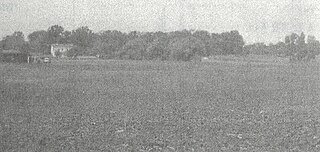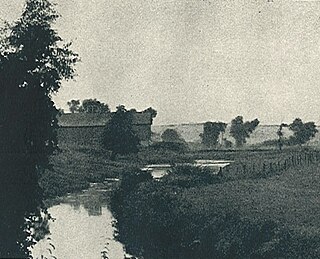
The Grand Village of the Illinois, also called Old Kaskaskia Village, is a site significant for being the best documented historic Native American village in the Illinois River valley. It was a large agricultural and trading village of Native Americans of the Illinois confederacy, located on the north bank of the Illinois River near the present town of Utica, Illinois. French explorers Louis Joliet and Father Jacques Marquette came across it in 1673. The Kaskaskia, a tribe of the Illiniwek people lived in the village. It grew rapidly after a French mission and fur trading post were established there in 1675, to a population of about 6,000 people in about 460 houses. Around 1691 the Kaskaskia and other Illiniwek moved further south, abandoning the site due to pressure from an Iroquois invasion from the northeast.

The Kincaid Mounds Historic Site c. 1050–1400 CE, is a Mississippian culture archaeological site located at the southern tip of present-day U.S. state of Illinois, along the Ohio River. Kincaid Mounds has been notable for both its significant role in native North American prehistory and for the central role the site has played in the development of modern archaeological techniques. The site had at least 11 substructure platform mounds, and 8 other monuments.

The Upper Mississippian cultures were located in the Upper Mississippi basin and Great Lakes region of the American Midwest. They were in existence from approximately A.D. 1000 until the Protohistoric and early Historic periods.

The Plum Island Eagle Sanctuary is a 52-acre island in the Illinois River owned by the Illinois Audubon Society. It was purchased March 24, 2004, to act as a wildlife sanctuary and to protect foraging habitat for wintering bald eagles. It is close to Matthiessen State Park and adjacent to Starved Rock State Park.

The Younge site is an archeological site located in Goodland Township, Lapeer County, Michigan. It is classified as a prehistoric Late Woodland site and was designated as a Michigan State Historic Site on October 29, 1971. It was added to the National Register of Historic Places on October 29, 1976.
The Joe Bell site (9MG28) is an archaeological site located in Morgan County, Georgia underneath Lake Oconee, but prior to the 1970s, it was located south of the mouth of the Apalachee River on the western bank of the Oconee River. The junction of these two rivers could be seen from the site. This site was first visited by Marshall Williams in 1968 at the suggestion of the site’s landowner, Joe Bell, who had discovered various artifacts while the site was being regularly plowed. Because of Interstate construction, Marshall Williams and Mark Williams discovered this site during surface surveys and excavations of the plowed areas. The site was excavated and analyzed by Mark Williams as part of his PhD dissertation. During the 1969 excavations, four areas within the site were designated for excavation. In Areas 1-3 various five foot square units were excavated. No excavations were done in Area 4 in 1969. Large quantities of small potsherds were discovered during these excavations, and they ranged from the Duvall Phase in Area 1 to Bell Phase in Areas 2-4. As part of the 1969 excavations, a road grading machine took off the topsoil of twelve strips on the site. This uncovered Features 1 and 2, and they were completely excavated. In 1977, the site was revisited by Marshall Williams and Mark Williams. Since various plans threatened this site, major excavations took place from June 15, 1977 until September 16, 1977 by Mark Williams. Most of the work centered on Area 2 or the Bell Phase portion of the site. The Bell Phase portion of this site was probably no more the 1.5 acres (1 ha). Because of time constraints, only 17 of 55 features were excavated, and no more than a handful of the 1100 posts were excavated. A few trips were made back to the site the following year with the help of volunteers, and approximately 80% of the area stripped by heavy machinery was mapped. Some of the features were trash features that consisted of a circular pit filled with food residues and pottery sherds. Evidence of a large circular structure or rotunda was found at the site. It was the social, political, and religious center for the inhabitants. A large quantity of the features was small, circular, semi-subterranean structures that were probably used as sleeping quarters on cold nights. Another structure found was warm weather structures. One major trash feature was found that had been deposited in a single episode and was burned during or after deposition. Numerous sherds were found in this pit, and many reconstructable vessels were present. Ethnohistoric literature of the Southeast suggests that this feature was formed during a Busk or Green Corn ceremony. The ceremony has been described as the physical cleansing of the town.

The Juntunen site, also known as 20MK1, is a stratified prehistoric Late Woodland fishing village located on the western tip of Bois Blanc Island. It was listed on the National Register of Historic Places in 1978.

The Ellerbusch site (12-W-56) is a small but significant archaeological site in the southwestern part of the U.S. state of Indiana. Unlike many sites created by people of the same culture, it occupies an upland site near a major river floodplain. Its existence appears to have been the result of the coincidence of periods of peace and growth in the related Angel site, which led some townspeople to leave their homes for new villages that were more convenient for resource gathering. Researched partly because of its small size, Ellerbusch has produced information that greatly increases present awareness of other small sites and of its culture's overall patterns of settlement in the region. Because of its archaeological value, the site was declared a historic site in the late twentieth century.

The Moccasin Bluff site is an archaeological site located along the Red Bud Trail and the St. Joseph River north of Buchanan, Michigan. It was listed on the National Register of Historic Places in 1977, and has been classified as a multi-component prehistoric site with the major component dating to the Late Woodland/Upper Mississippian period.
The Griesmer site (La-3) is located on the Kankakee River in Lake County, Indiana, about a mile southeast of Schneider, in Northwestern Indiana. It is classified as a Prehistoric, multi-component site with Middle Woodland, Late Woodland and Upper Mississippian occupations. The deposits were not stratified, but observation of the types of artifacts present, together with radiocarbon dates, helped to define the sequence of occupations at the site.
The Fifield Site (Pr-55) is located on Damon Run Creek in Porter County, north-western Indiana. It is classified as a late prehistoric, single-component Upper Mississippian Fisher village.
The Hoxie Farm site (11Ck-4) is located on Thorn Creek in Thornton, Illinois Cook County Forest Preserve in Cook County, Illinois, near the city of Chicago. It is classified as a late prehistoric to Protohistoric/Early Historic site with Upper Mississippian Huber affiliation.
The Palos site (Ck-26) is located on the Cal-Sag Canal in Cook County, Illinois, United States, near the city of Chicago. It is classified as a Protohistoric to early Historic site with Upper Mississippian affiliation.

The Knoll Spring site (11Ck-19), aka Au Sagaunashke village, is located in the Sag Valley, Palos Hills, in Cook County, Illinois, near the city of Chicago. It is classified as a late prehistoric site with Upper Mississippian Huber affiliation.
The Oak Forest Site (11Ck-53) is located in Oak Forest, Cook County, Illinois, near the city of Chicago. It is classified as a late prehistoric to Protohistoric/Early Historic site with Upper Mississippian Huber affiliation.
The Anker Site (11Ck-21) is located on the Little Calumet River near Chicago, Illinois. It is classified as a late prehistoric site with Upper Mississippian Huber affiliation.
The Carcajou Point site is located in Jefferson County, Wisconsin, on Lake Koshkonong. It is a multi-component site with prehistoric Upper Mississippian Oneota and Historic components.
The Midway Site (47LC19) is a prehistoric Upper Mississippian Oneota site in La Crosse County, Wisconsin. It is located about 10 miles north of LaCrosse near the juncture of the Black and Mississippi Rivers.

The Walker-Hooper Site (47-GL-65) is a multicomponent prehistoric site complex located on the Grand River in the Upper Fox River drainage area in Green Lake County, Wisconsin. It consisted of at least 2 village sites and several mound groups. It was excavated by S.A. Barrett under the auspices of the Milwaukee Public Museum in 1921 and again in 1967 by Guy Gibbon of the University of Wisconsin-Milwaukee. The major component of the site is an Upper Mississippian Oneota palisaded village. Other components were also present, mainly Late Woodland but also including Archaic, Early Woodland and Middle Woodland.
The Booker Site is an archeological site in Sny Bottom of the Mississippi Valley. The investigations for this site began during August and September 1990 by the Contract Archaeology Program of the Center for American Archaeology. Excavations for this site began in 1993 in Pike County, Illinois.









